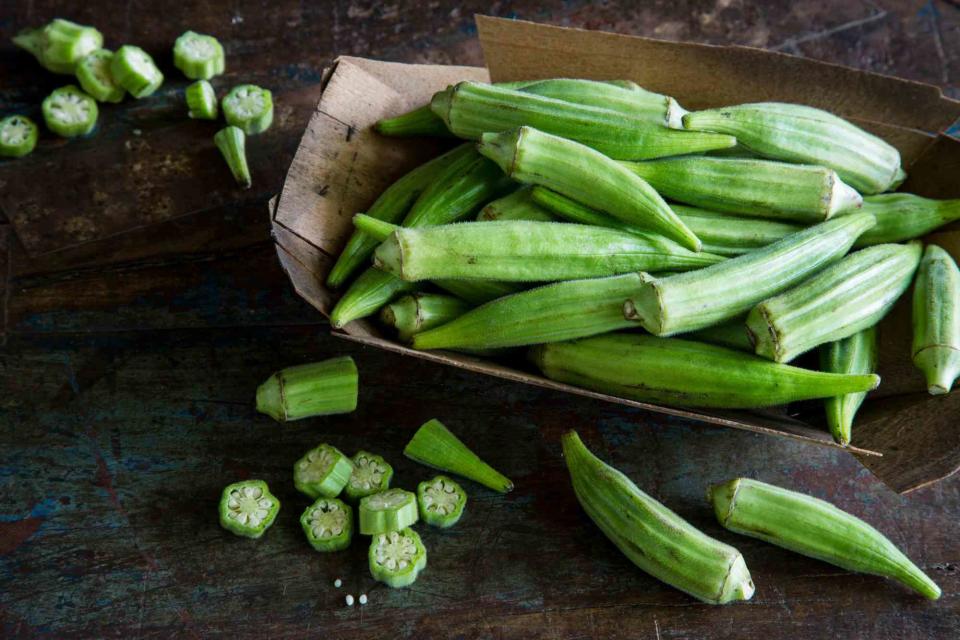What Makes Okra "Slimy," And What Can You Do About It?
Love it or loathe it, okra's texture can be beneficial to some dishes.

Fact checked by Khara Scheppmann
Okra, a vegetable prominently grown throughout the South and used in countless dishes, can be a somewhat polarizing piece of produce. While okra fans praise its aromatic, grassy flavor and gentle sweetness, some diners object to okra's unique texture, which is sometimes described as "slimy". If you've ever wondered what causes's okra's signature mouthfeel and whether home cooks can take steps to reduce its intensity, read on.
What Is Okra Slimy?
When you bite into a cooked okra pod, you might notice a gooey texture at the interior. There's a scientific explanation for okra's sliminess: "Okra pods are mucilaginous," says food safety consultant Millie Ngaru, who consults with Fast Food Menu Prices. Mucilaginous foods contain a type of soluble fiber that dissolves in water and produces "a gooey and slimy texture."
Ngaru goes on to explain that the mucilage (which, yes, has the same root word as "mucus") "is made up of sugar residues called exopolysaccharides and proteins called glycoproteins, which increase once the heat is applied."
While raw okra pods (which are entirely edible!) release less mucilage than cooked pods (and are therefore less slimy), the mucilage is still present, so you're likely to perceive a bit of a gooey sensation nevertheless.
Can Okra's Sliminess Be Eliminated?
While the production of mucilage is a natural property of cooked okra, there are ways to downplay its effects and to make the slimy texture less prominent. One popular way to reduce okra's sliminess is to "soak it in vinegar for 30 minutes [before cooking with it], which helps to break up and dissolve the slime," says food scientist, food industry consultant, and author Bryan Le. Experts believe that okra's mucilage is at its most viscous when it's at a neutral or basic pH, so soaking it in acidic vinegar can counteract that process. This is also why pickling okra is a smart way to turn the vegetable into a crunchy and flavorful snack.
Chef, recipe developer, and okra enthusiast Sylvia Fountaine of Feasting at Home tells us that another smart way to cut back on okra's gooeyness is to "cook it over high heat for a short amount of time." She says that "the more okra cooks, the slimier it gets, because the sugars that create the slime are released."
Therefore, quick high-heat cooking methods like deep frying, stir-frying, air-frying, grilling, and sautéing prevent the mucilage from overdeveloping and becoming sticky. If you then season with another dose of acid—Fountaine recommends "adding a squeeze of lemon, adding a tablespoon of your favorite vinegar, or serving with tomatoes"—you'll get the multilayered vegetal and herbaceous notes along with a pleasantly toothsome texture.
What Are the Advantages of Okra's Unique Texture?
Although okra's slimy quality can turn some veggie fans against it, there are also plenty of reasons to embrace okra for exactly what it is. For one thing, some diners discover, to their surprise, that the mucilaginous texture is more appealing than they expected, and okra's nuanced flavors can make the "slime" a treat to consume.
But even if okra's gooey innards don't strike your fancy on their own, they can serve a very valuable purpose "as an efficient thickener that binds together oils and water," says Le.
Okra's thickening powers prove useful for soups and stews, including one of its most famous applications: as a key thickener for Cajun gumbo. This slow-cooked Louisiana specialty made with a flour roux, the "holy trinity" of peppers, celery, and onion, and a choice of poultry, seafood, and/or andouille sausage needs a thickening agent to give it a hearty texture, and Cajun and Creole chefs either use filé powder (an herbal powder made of sassafras) or locally-harvested okra for this purpose.
Give okra a try in these delicious recipes:
Pickled Okra
Fried Okra
Okra Creole
Classic Okra and Tomatoes
Shrimp and Okra Gumbo
Crunchy Okra-and-Corn Salad with Ranch Dressing
For more Southern Living news, make sure to sign up for our newsletter!
Read the original article on Southern Living.

